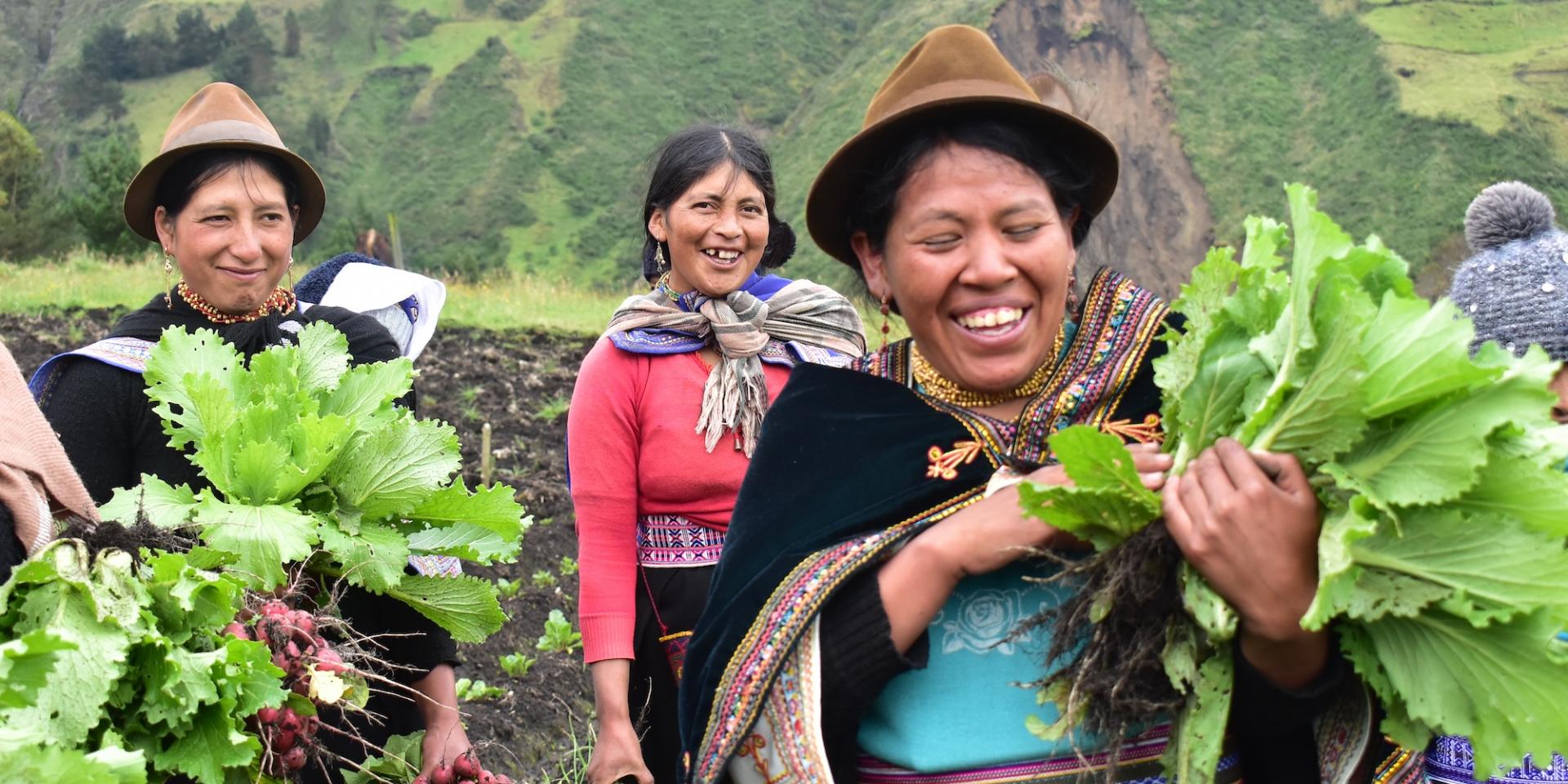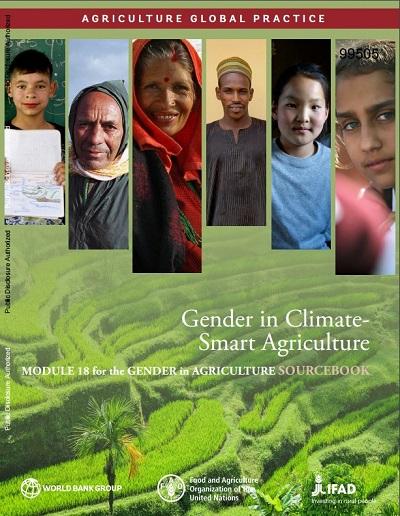Better use of gender-disaggregated data will improve climate-smart agriculture programs

Key messages:
- Persistent, significant gaps in gender-disaggregated data in climate-smart agriculture programs and policy stem from a lack of
- high-level commitment and intention to seek gender equality and social inclusion within climate-smart agriculture
- clear, standardized indicators to measure impacts
- resources, capacity and time to effectively capture disaggregated data
- However, the collection, analysis and use of gender-disaggregated data in climate-smart agriculture is improving—although organizational practices vary widely—with increasing use of data from diagnostic and facilitation tools, standardized sources of impact evidence, and digital data collection.
- Climate-smart agriculture programs and policy require changes such as
- Creating an alliance of organizations to steer, model, and advocate for integrating gender equality and social inclusion
- developing standardized guidance on how to integrate those metrics
- measuring gendered impacts in climate-smart agriculture programs
The Climate-smart agriculture (CSA) framework aims to: sustainably improve agricultural productivity and enhance food security, increase farmers’ resilience and adaptation to climate change, and reduce and/or remove greenhouse gas emissions where possible. However, it does not include an objective about gender equality, social inclusion, or other equity issues. For instance, the seminal 2010 FAO paper on CSA did not address gender, gender equality, or equity—and methods or metrics to address these issues were not proposed.
In the years following the 2010 FAO paper, gender was retrospectively included as something that should be ‘mainstreamed’ in the pursuit of the three primary objectives of CSA. The weakness of the CSA framework for gender integration has become more apparent, so discourse and practice relating to gender in agriculture are progressing from gender-sensitivity and mainstreaming, toward gender-responsive and eventually gender-transformative.
The lack of expectations and ambition for advancing gender equality within CSA is illustrated by a dearth of commitment to measurement systems and actions that would track progress on those gender and equity issues. Our forthcoming study therefore sought to better understand what gender-disaggregated data is available in CSA programs and to identify gaps.
Gender-disaggregated data use and positive trends in climate-smart agriculture programs
We conducted key informant interviews with representatives of organizations across a variety of sectors (government, NGO, research, etc.) and geographies.
The interviews indicated that some organizations were more intentional about integrating gender into all aspects of their projects’ cycle, including design, implementation, and monitoring and evaluation—while others mainly focused on collecting gender-disaggregated data during monitoring and evaluation.
To varying degrees, some organizations also:
- collected, analyzed, and used gender-disaggregated impact data to better understand the gendered impacts of adopting CSA practices and technologies
- collected age-disaggregated data
- considered age as a factor when designing and implementing programs
Only a couple of organizations considered other marginalized groups— such as ethnic minorities or people with disabilities— in their programs, but did not make targeted attempts to collect data from these groups.
The interviews also revealed several positive trends such as:
- using diagnostic and facilitation tools to develop projects and workplans that rely on inclusive approaches and qualitative data to co-create, implement, and monitor action plans
- using standardized sources of impact evidence—such as the Women’s Empowerment in Agriculture Index (WEAI), Abbreviated WEAI (A-WEAI) and Project-level WEAI (pro-WEAI)—which may facilitate comparisons across socioeconomic contexts and implementation strategies to increase knowledge of what works and what does not
- digitalizing data collection (e.g., phone-based surveys), which promises to reduce costs, time, and errors; and can facilitate community-based monitoring in near-real-time or longer
We note that ensuring digital tools increase women’s levels of participation in data capture and analysis, and as key informants, should be a priority for organizations implementing CSA programs.
Gaps in use of gender-disaggregated data in climate-smart agriculture programs
There are significant and interconnected gaps in the collection, analysis, and use of gender-disaggregated data (or disaggregated by other intersectional variables) stemming from a focus on binary gender dynamics, antiquated gender-sensitive approaches, and ignoring of fundamental issues of power dynamics and social and political relations and norms.
This has constrained our ability to assess the benefits, costs, and impacts of CSA on women or vulnerable groups of people.
The gaps in collecting, analyzing, and using disaggregated data include and are sustained by:
- lack of intention and high-level commitment to seek gender equality or social inclusion outcomes in CSA and, by extension, to achieve UN SDG 5 (Achieve gender equality and empower all women and girls)
- lack of central and clear guidance on impacts envisioned and indicators required
- inadequate resources at all levels
- inadequate training and staffing at the project level
- limited use of intersectional data for impact analysis
Although the relatively small number of interviews cannot fully represent broad geographies or organizations, our scoping review provides key insights into the spectrum of gender-disaggregated data collection, use and analysis.
Ideas for generating better evidence and prioritizing gender-disaggregated data in future programs
Our findings serve to inform how people generate evidence in the future, and how to prioritize and mainstream gender-disaggregated data into CSA policies and programs.
The findings of the review suggest that development institutions with a focus on CSA programs should create an alliance of organizations to model and advocate for greater leadership from key international and regional institutions to:
- Mandate the integration of gender equality and social inclusion across all pillars in CSA programs.
- Adopt protocols for cost-efficient impact measurement and longer time periods for collecting data.
- Optimize allocation of funding and expertise by prioritizing disaggregated impact data collection and analysis at the program level and disaggregated reach/participation/adoption data collection and analysis at the project level.
The findings of the review also suggest that both development institutions and implementing organizations with a focus on CSA programs should:
- Provide more guidance to development actors about decision-making that integrates climate risk analysis and climate information.
- Ensure adequate gender and technical expertise to implement gender-transformative approaches in CSA projects.
- Promote social analysis and action, and the use of gender analyses and gender-sensitive climate vulnerability and capacity analyses.
- Develop guidance about how to move beyond monitoring a community’s participation in CSA programs and adoption of CSA practices to evaluate the outcomes and impacts of interventions and practices for women or vulnerable groups.
- Collect, analyze, and use gender-disaggregated data throughout program implementation to inform present and future programs.
- Collect and analyze gender-disaggregated data to better understand the impacts that can be attributed directly to women’s participation in CSA programs.
- Develop and implement simplified measures and systems for communities to monitor the extent to which gender equality and social inclusion is mainstreamed within CSA program implementation.
References

Gender in climate-smart agriculture: module 18 for gender in agriculture sourcebook
Climate-smart agriculture sourcebook
“Climate-Smart” Agriculture: Policies, Practices and Financing for Food Security, Adaptation and Mitigation
FAO. 2010. “Climate-Smart” Agriculture: Policies, Practices and Financing for Food Security, Adaptation and Mitigation. Rome, Italy: FAO.
Moving Beyond Sisyphus in Agriculture R&D to Be Climate Smart and Not Gender Blind
Anderson Simon, Sriram Vidhya. 2019. Moving Beyond Sisyphus in Agriculture R&D to Be Climate Smart and Not Gender Blind. Frontiers in Sustainable Food Systems, vol 3.
DOI=10.3389/fsufs.2019.00084